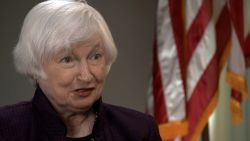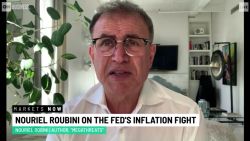The market for US Treasuries, worth roughly $24 trillion, is considered the world’s most important. Its smooth operation directly impacts both America’s ability to run its government, and the health of the broader financial system, which hinges on the view among traders that US debt is a safe bet.
So what would happen if the Treasury market were to experience a sudden breakdown?
It’s a question that both US officials and Wall Street banks have been fielding more often since the United Kingdom experienced a meltdown in its own government bond market. The Bank of England was forced to stage an emergency intervention.
Fears are brewing that a showdown between Republicans and President Joe Biden over the debt ceiling in 2023 could present a similar moment of reckoning.
“America should not be held hostage by members of Congress who think it’s alright to compromise the credit rating of the United States and to threaten default on US Treasuries, which are the bedrock of global financial markets,” Treasury Secretary Janet Yellen told CNN on Thursday.
Trading in US debt has been stretched more thinly than usual, as uncertainty keeps investors on the sidelines and foreign central banks and governments look for ways to support their struggling currencies.
That’s fanning fears that a sudden shock, should one occur, could be particularly jarring.
“Most recognize there is an underlying fragility in the market today,” said Mark Cabana, head of US rates strategy at Bank of America. “Fragile things can break easily.”
An uptick in volatility
Yields on benchmark 10-year Treasuries, which move opposite prices, have been rising sharply, topping 4.2% this month from just 2.6% at the beginning of August and 1.5% at the start of the year.
Those large moves in the typically incremental world of government bond trading reflect a decline in demand.
While Treasuries usually serve as a safe-haven investment in times of uncertainty, a lack of clarity about how long the Federal Reserve will keep raising interest rates — and how long high inflation will persist — is making traditional buyers more hesitant.
Yellen has said her agency is monitoring the situation closely, acknowledging that trading is “reflecting greater uncertainty about the economic outlook,” though “volumes are robust and investors are able to execute transactions.”
“Treasury is working with financial regulators to advance reforms that improve the Treasury market’s ability to absorb shocks and disruptions, rather than to amplify them,” she said in a speech this week.

Treasuries aren’t immune to turbulence when markets begin to go haywire, if recent history is a guide. In March 2020, for example, fear about the coronavirus pandemic caused rare disruptions. The Federal Reserve was able to restore confidence, but only after it announced it would buy government bonds on a massive scale.
For now, the market appears strained but under control. But Brad Setser, a senior fellow at the Council on Foreign Relations who studies financial vulnerabilities, is paying attention to the extent to which central banks or governments in countries like Japan are offloading Treasuries.
As the US dollar has embarked on a breakneck rally, pushing down other currencies, officials have stepped in to try to limit the damage. Japan, for example, has attempted to prop up the foundering yen, which recently fell to its weakest level against the US dollar since 1990.
While official data often lags, Setser, a former Biden administration adviser, said there is “growing evidence that some central banks are starting to become modest sellers of Treasuries.”
The Federal Reserve has also started shrinking its pandemic-era holdings, a process known as quantitative tightening. A bump in bond supply could push yields up even further if demand stays muted.
“The amount of Treasuries that the market needs to absorb is obviously going to increase with the Fed’s quantitative tightening, and uncertainty about the path for interest rates is creating more intrinsic volatility in the market,” Setser said.
Debt ceiling fears
Signs that the Treasury market is more delicate than usual are putting investors and regulators on alert, especially after what recently played out in the United Kingdom.
An investor revolt over plans unveiled by former Prime Minister Liz Truss in September to slash taxes while ramping up borrowing unleashed chaos in the government debt market. The Bank of England had to announce three separate interventions to restore calm as pension funds that leaned on derivatives came under pressure.
“What’s got people worried is what happened in the UK,” said Joseph Gagnon, a former Fed official and senior fellow at the Peterson Institute for International Economics.
The US pension industry is structured differently from the United Kingdom’s, and many of the factors that triggered the fallout were specific to Britain.
Investor confidence in the United Kingdom has diminished since it voted for Brexit in 2016, noted Kathleen Day, a lecturer at Johns Hopkins University who has studied the history of financial crises.
Still, the episode caught the attention of traders of US government debt and policymakers. One concern is that if Republicans take control of one or both chambers of Congress after this fall’s midterm elections, they will leverage the debt limit — which will likely need to be raised in 2023 — as a negotiating tactic with Biden.
“The debt ceiling is probably the biggest institutional quirk in the US that carries with it some global risk and risk to the Treasury market,” Setser said.
While brinkmanship over the debt limit has become commonplace, the stakes could be higher now that financial markets are on edge.
“If the US does not raise its debt ceiling and defaults on its debt, that is an Armageddon moment,” Day said.
Yellen told CNN that it’s “utterly essential” that the debt ceiling is raised when necessary.

























